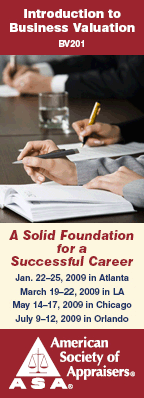
| BV experts weigh in on the factors that impact value conclusions Our coverage of Professor Aswath Damodaran’s well-attended session at the recent AICPA/ASA conference in Las Vegas (see issue #74-2) generated a fair amount of buzz among readers. Consider, for instance, the comments offered by Stephen Koons CPA/ABV, CFF, ASA, who wrote: “I am troubled and very offended by the comment made by Professor Damodaran as quoted in your latest BVWire suggesting that we, as valuation professionals, ‘Have a number in mind, and spend the entire process trying to back into this number…’ in the performance of a valuation. This suggests that we violate one of the basic tenets of our profession: independence, lack of bias and intellectual honesty.” Few would argue (BVWire includes the esteemed professor in this group) that BV analysts operate with anything less than the utmost in professional integrity. The reader’s point, however, does raise key questions. Bill Quackenbush, ASA, CBA posited a few in a recent issue of the ASA E-update, published by the Business Valuation Committee of the American Society of Appraisers. With each point, Quackenbush offers interesting food-for-thought:
What do you think? Quackenbush is seeking comments to the last query; you can e-mail him your thoughts at bill@adventvalue.com. Quackenbush will follow up in a future ASA E-update column, which we look forward to reading and providing further reports. Good news for the BV profession? Securities litigation on the rise In our November Business Valuation Update™ article, “What Will the Wall Street Meltdown Mean to the BV Profession?” several respected industry insiders surmised that the current financial crisis will be the basis of a lot of future litigation that will require business valuation experts. Data suggests this might actually be the case. Indeed, Securities and Exchange Commission (SEC) enforcement action settlements are projected to reach a three-year high in 2008, continuing a dynamic period of SEC enforcement since the enactment of Sarbanes-Oxley (SOX) in 2002. This is reported in the National Economic Research Associates (NERA) Economic Consulting’s study, SEC Settlements: A New Era Post-SOX. NERA reviewed every SEC litigation release and administrative proceeding document published from July 31, 2002 through September 30, 2008 for its study.
In conjunction with the release of its study, NERA has launched a website that features additional statistics and analysis, as well as a searchable database of documents relating to SEC settlements. You can check out the new website and the study here. New changes to report submission requirements mean more analysts can seek ASA accreditation Have you heard? The American Society of Appraisers’ Business Valuation Committee recently voted to change, effective immediately, the number of reports required for advancement to the ASA designation from two reports to one report. This shift is retroactive for two years, according to a just-released Note from the Chair, Terry Allen, CPA/ABV, ASA. According to Allen’s explanation of the change:
Those in need of additional information should contact accreditation specialist Sabri Math at smath@appraisers.org or at 703.733.2106. BV experts looking to keep up with happenings within the industry’s professional associations will find BVR’s Professional Association Directory, 2009 Edition, of particular interest. Inside this updated publication are brief descriptions of each association, their relevant publications and professional certifications where applicable, key contact information, and the composition of certain key committees and officers. To download this comprehensive—and free—reference click here. Medical practice valuations diverge by nearly $1 million In an all too common scenario in divorce (and other) courts, the opposing experts in Pellom v. Pellom submitted appraisals that were worlds apart. In this case—decided on December 2, 2008 by the North Carolina Court of Appeals—the husband’s expert appraised his 11% interest in an anesthesiology practice at $183,000, while the wife’s expert determined it was worth $1,267,000. The court examined the following factors and competing claims:
Which expert ‘won’? The trial court adopted the $1.27 million valuation by the wife’s expert without adjustment. It found that the wife’s expert: 1) Used the appropriate income figures, known as of the valuation date; 2) used an acceptable MGMA survey, taking multiple factors into account—including clinical hours worked and retirement benefits; 3) correctly considered that the husband’s practice permitted nurse anesthetists to perform a portion of its 2,000 annual procedures; and 4) correctly valued the practice’s goodwill and accounts receivable. The court of appeals confirmed the trial court’s valuation conclusion in all respects. Look for a complete abstract of the case in the February 2009 Business Valuation Update. For those interested in insights on healthcare valuation, we’ve just posted a new Free Download at BVResources, “Medical A/R: Top Issues That Impact Your Valuations,” by Mark Dietrich, CPA, ABV, excerpted from our latest industry release, BVR’s Guide to Healthcare Valuation, co-edited by Dietrich and Cindy Eddins Collier. The new Guide covers all the complicated aspects of healthcare valuation, from interpreting regulatory standards to applying compensation and other physician benchmarking data. To find out more about the Guide—including an online view of the table of contents and introduction—click here. Last but not least, do not miss Collier and others at the 26th annual LEI National CLE Conference in Vail Colorado, January 3- 7, 2009. The business valuation track features Collier on healthcare valuations and case law update, Nancy Fannon on avoiding Daubert challenges; Ron Seigneur on the liquidation premise in valuations and reasonable compensation; Tom Hilton on emerging issues in electronic evidence, and lots more. Many of the BV speakers will be crossing over to address attorney tracks on valuation issues—and networking with the 600+ attendees in one of the most outstanding ski resorts in the world. Act now: conference lodging is available at reduced rates until December 15, 2008. Estate & Gift Tax Guide offers analysis of Astleford, Bigelow, Holman and Jelke The new 2009 Edition of BVR's Guide to Business Valuation Issues in Estate and Gift Tax includes new court case abstracts from the past year, including in-depth analysis on the Astleford, Bigelow, Holman, and Jelke decisions. Several new articles exclusive to the Guide have also been added, including Will Frazier’s Non-Marketable Investment Company Evaluation (NICE) method and Owen Fiore’s overview of the impact of the before mentioned court decisions, as well as a list of success factors for creating FLPs/LLCs. Other new additions include full-text court decisions, teleconference transcripts, and presentations, which have all been added to the accompanying compact disc. For more information on BVR's Guide to Business Valuation Issues in Estate and Gift Tax or to order, click here. Recommended reading on the SEC proposed transition to IFRS It has been almost a month since the SEC issued its much-anticipated “roadmap” for the proposed transition by U.S. public companies to use International Financial Reporting Standards (IFRS) instead of the U.S. Generally Accepted Accounting Principles (GAAP). The commission set a longer-than-expected 90-day comment period for the proposal, which puts forth milestones that, if met, could lead to the required use of IFRS by U.S. issuers in 2014. (Comments are due February 19, 2009). For an interesting take on this subject, take a look at the recent BNET Financial Services article Switching to IFRS: An Interview with Deloitte, which features comments from the firm’s D.J. Gannon, the partner who heads Deloitte’s IFRS solutions center in Washington, D.C. Noteworthy: When asked about private companies, Gannon says, “They shouldn’t be left out of this debate. There is a program targeted for private companies. More should be known by the middle of next year.” Guidance for private companies is certainly something to keep our eye out for…. Valuing IP portfolios for pharmaceuticals and medical devices With billions spent on medical research and many billions more generated in revenues from resulting patents, it is no wonder there are disputes in the pharmaceutical and medical device industry over lucrative intellectual property assets and often widely disparate views on their value. As any BV practitioner knows, the ins-and-outs of healthcare valuation are full of potential pitfalls. In our 100-minute teleconference, Pharmaceuticals & Medical Devices: Building & Valuing Intellectual Property Portfolios, Mike Pellegrino of Pellegrino & Associates and Dustin DuBois with the law firm of Ice Miller will tackle the unique challenges in pharmaceutical and health care patents. Among other things, attendees will learn how to wade through the science to get to the value proposition, develop an understanding of the regulatory process and its impact on value, and meet the unique challenges in the pharmaceutical and medical device space. The event—which includes a live Q&A—will take place on Thursday, December 11, 2008 at 1 p.m. Eastern time. For more information, click here.
|
To ensure this email is delivered to your inbox,
please add editor@bvwire.com to your e-mail address book.
We respect your online time and privacy and pledge not to abuse this medium. To unsubscribe to BVWire™ reply to this e-mail with 'REMOVE BVWire' in the subject line or click here.
Copyright © 2008 by Business Valuation Resources, LLC
BVWire™ (ISSN 1933-9364) is published weekly by Business Valuation Resources, LLC
Editorial Staff | Advertise in the BVWire | Copyright Notice
|
|



